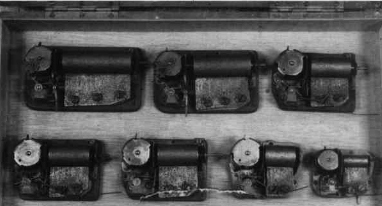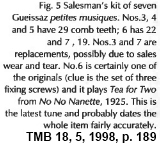|
GUEISSAZ „The Gueissaz family in L´Auberson was one of the families who stayed in music box manufacture the longest, some 130 years, surviving all the crisis. In the end they opted to convert to plastic injection molding.“ (Piguet 2004, p. 219) Die folgende Aufstellung fußt im wesentlichen auf der grundlegenden und grandiosen Monographie von Jean Claude Piguet (franz. 1996, und aktualisiert engl. 2004). In den so genannten „Merkwörtern“ finden sich die jeweiligen Vornamen in abgekürzter Form und eventuell der jeweilige Ortschaft. Alix Gueissaz (L'Auberson) Gueissaz Frères (La Sagne) Gueissaz Fils & Cie: Jules, Philippe, Félix, Ami and Gustave Manufacture de pièces à musique Philippe, Ami, Gustave and André Gueissaz André Gueissaz André Gueissaz & Co: André Gueissaz sen. and his four sons Roger, Edgar, René and André-Paul Gueissaz Roger, Edgar, René and André-Paul Gueissaz André-Paul Gueissaz, St. Croix Roger, Edgar, René Gueissaz André Gueissaz-Jaccard Gueissaz-Jaccard Alix Gueissaz / Gueissaz Fils & Cie. (L´Auberson), 1848/1852–1884
"L´Auberson, Switzerland. Made musical boxes [...] including some large ones with dancing dolls, timpani, voix céleste and bells, one of which was for the Shah of Persia."
“It was Alix Gueissaz who, in the middle of the nineteenth century, started to manufacture music boxes, at Chez-les-Jaques. The letterhead and catalog of the company mentioned 1848 but the Trade Register read 1st January 1852.” “Judging from the eight successive trade names of the Gueissaz enterprise, it was a family business, brothers and sons, who suceeded one another, thus ensuring continuity over five generations. Alix Gueissaz had five sons who all worked towards a common goal, divided between music box manufacture and trade on the one hand, and work on the farm on the other. This mixed activity lasted well into the 1960s.” (Piguet 2004, p. 219)
Exposition universelle de 1878 Paris “After twenty-five years of experience, the head of the business decided to take part in industrial fairs. In 1878, he went to Paris, together with the Bornand-Meylan and Edouard Jaccard companies and proved himself by bringing back a bronze medal. ‘Messrs. Gueissaz & Co in Sainte-Croix offer, for the very low price of 500 francs, a music box which is entirely satisfactory, with a very pure and most pleasant musical sound.’ (FAS 21st December 1901).” National Exhibition in Zurich in 1883 Renewed success came at the National Exhibition in Zurich in 1883, where Alix Gueissaz was congratulated for his quality of sound and excellent workmanship and obtained a diploma of honor.” (TMB 18, 5, 1998, S. 136, Nr. 15; Bellamy, Music Makers of Switzerland, (2015), p. 6; Piguet 2004, p. 219ff.) Gueissaz Frères “The directory published in 1852 listed, in the category music box manufacturers, the name of Gueissaz Frères in La Sagne. They were moreover mentioned as music box exhibitors at the Exposition universelle of Paris in 1867. Gueissaz-Frères "There is no further trace of the company.” Jean Claude Piguet konnte keine gemarkten Spieldosen dieses Herstellers finden, die weiter unten von der TMB 16, 5, 1994, S. 128 zitierten beiden Instrumente sind von Gueissaz & Fils Gueissaz Fils & Cie: Jules, Philippe, Félix, Ami and Gustave (1884) “The head of the company had shown his mettle, and feeling old age coming on – Jules, Philippe, Félix, Ami and Gustave – who went into partnership on 15th March 1884, under the name Gueissaz Fils & Cie. They continued to develop their activities and were interested in the very remote Middle-Eastern markets.” The Persian boxes 1.) “At the end of the nineteenth century, Félix and Auguste Gueissaz took the courageous decision to travel to Iran where they set up a comptoir. From there they visited many countries, bringing back orders which they sent to L´Auberson.” “They were so clever that they curried favor with the court of the Shah who placed a most prestigious order: a luxury cartel, which was to be the pride of the Gueissaz company. It was finished in April 1896, just one month before its consignee was assassinated in Teheran. It played persian music, which had probably been arranged by Octave Chaillet. This cartel embodied everything of the very best available at the time, with two drums and cymbals, six bells, a voix céleste of forty-one notes … and two birds in their nest lined with leaves. It survived all the successive changes in government in Iran and was finally sold, at Sotheby´s in London, in January 1985, for the sum of 19,000 pounds sterling.” 2.) “Later on, the company made a music box for the son of the Shah, which had twenty cylinders playing six tunes each, i.e. 120 melodies [better: pieces of music], of which 72 were taken from the Persian repertoire. It cost 6,400 francs, paid in December 1901.”
Teilnehmer bei der Nationalen Ausstellung in Zürich 1883
Exposition universelle, Paris 1889“Together with Paillard, Gueissaz was the only local company to travel to the Champs de Mars in Paris for the Exposition universelle of 1889. It was a roaring success, with 33 million visitors. Gueissaz was awarded a silver medal and, on the basis of its success at the Zurich and Paris exhibitions, the company published a catalog which presented its entire product range “from handcrank children´s toys to the most elaborate music boxes”, adding that it also made boxes in all types and sizes not mentioned in the price list and supplied special tunes at an additional price of two to ten francs per item.” “The catalog mentioned that payment was due in thirty days, that the goods were dispatched ex factory at the risk of the consignee and that complaints were admissable within eight days of reception. As the catalog was mainly destined for reailers, the author gave the following advice: ‘We deem it advisable to inform our clients that by increasing the number of tunes without change of format, the music is inferior and less harmonious on account of the reduced number of teeth of the comb; thus a ten-tune box of 7.5 inches with 46 notes will be inferior from a musical point of view to a six-tune box of 7.5 inches with 77 notes.’ Followed by instructions to operate and maintain the large music boxes, as well as a description of boxes in imitation rosewood and inlay: ‘The Rich Box is veneered in burled walnut, citron-wood, maple, etc.; the lid is domed with a black polished, molded base’”. ”Gueissaz & sons offered classical boxes, either finished or the movement only, cartels and small models destined for Brazil, with smaller dimensions in order to pay only five cents rather than 5,000 reis of import duty for dimensions less than twenty-five centimeters! In particular the Sublime Harmonie was recommended because it ‘produces the effect of two music boxes playing simultaneously. The result is powerful rendition and the capability of reproducing the fortes and the pianos, which is faciliated by the fact that the two distinct pieces playing together constitute two separate sound compartments, enhancing the vibration oft he teeth’. For ninety-five francs, cou could have a movement playing six tuned, for 231 francs you could take home the one playing twelve tunes and for 327 francs you got the accompanying drums and bells.” “The most elaborate music boxes offered drums, bells, castanets and dancing dolls, or even voix céleste flutes in which the sound was obtained by the free-floating reeds vibrating under the influence of a bellows, like in a harmonium. For a piece playing twelve tunes, however, with ‘2 Chinese striking 4 bells, 2 beautifully dressed dancing dolls, 1 Chinese playing on 2 drums, a fine nickel-plated movement’, you had to lay out 1218 francs ex factory and 1348 francs delivered in Paris. But the most beautiful was undoubtedly the Rechange, presented on a Louis XV-style table, with a drawer capable of holding six cylinders of eight tunes each, an instrument specially recommended for dining rooms and hotels.’” “The more modest public houses had to be content with dressers to play with a coin, or jukeboxes. For 264 francs, you could become the owner of a music box playing two tunes [...] with zither and indicator; if you were better off, you could have on top of that drums, bells and even puppets. [...] At the end of the catalog came the spring boxes, the round or square handcrank boxes selling for sixteen francs a dozen, i.e. one franc thirty per piece for the single-tune, twelve-note boxes. But this was not the kind of product that the Gueissaz brothers wanted to promote. They preferred the large boxes which were the object of strong competition from the disc-playing boxes and gramophones at the turn of the century.” Teilnehmer und Silber-Medaillen-Gewinner bei der Pariser Weltausstellung von 1889 (bei der der Eiffelturm vorgestellt wurde und auch der Edison-Phonograph)
Siebentletzte Zeile: In Besançon war die Druckerei Valluet beheimatet “[...] Gueissaz participated in the Exposition universelle in Paris in 1900, which confirmed their allegiance to the older type of product and their specialization in special products, of customized dimensions, e.g. an automaton with mechanical drums, playing ten tunes. But ’the most important piece shown in the Persian room is a semi-bass flute, voix célestes, with orchestra and singing birds, 20 inches, 36 lines, five interchangeable six-tune cylinders mounted on a table made of burl walnut with the coat of arms of the Shah, adorned with a clock playing a tune when striking the hour. This piece requires professional skill to overcome the problems related to the assembly of diverse elements into one strictly disciplined entity.’ Thus wrote a connoisseur, Louis-Philippe Mermod, in his report to the jury. Gueissaz brothers obtained a silver medal.” “The following year, in a more modest context, Gueissaz went to the National Exhibition in Vevey under the name Community of Manufacturers from L´Auberson, which won a gold medal. At the time, the company was still operating in the building at Grand-Rue 180, with the workshop installed on the ground floor. It employed seven people, among whom André Gueissaz, who was a messenger boy, and who learnt the trade through interaction with various members of the family.” Manufacture de pièces à musique 1884 –1908 Zur Sitemap Fabrique de pièces a musique bitte hier klicken
Philippe, Ami, Gustave and André Gueissaz “In 1908, the second generation after Alix handed over control of the company. A new name was registered with Philippe, Ami, Gustave and André Gueissaz. Even though the decline of the large music boxes was considered preoccupying, the company survived and concentrated on the small box.” André Gueissaz (1921–1945) “In 1921, following the withdrawal of two of the partners, the company was transformed into a private company in the name of André Gueissaz, who survived the successive economic crises of the twenties and thirties. He participated in the National Exhibition in Zurich 1939, together with six other local manufacturers.” André Gueissaz & Co: André Gueissaz sen. and his four sons Roger, Edgar, René and André-Paul Gueissaz (1945 –1954) “Once the war was over, the Gueissaz company – a sure sign of the times – once again changed its destination and became a partnership under the name André Gueissaz & Co., associating André senior and his sons Roger, Edgar, René and André-Paul. The factory as it is today, situated at the western end of L´Auberson, was built in the hope that the expected increase of music box orders would materialize.” Roger, Edgar, René and André-Paul Gueissaz (1954 –1959) “In 1954, Gueissaz became a limited company, closely associating the four brothers and the entire family with production. As it had done in the beginning, the company participated in the activities of the Societé industrielle et commerciale and showed the same lack of enthusiasm as the other manufacturers in fixing and observing minimum prices for the small music boxes. However, they tried to find a solution to the terrifiying competition among the music box manufacturers, under growing pressure from Japan.” “André Gueissaz bought his cylinders from Charles Martin and subsequently acquired machinery to make injection-molded cylinders and bedplates himself. Around 1957, he introduced the diversifikation process which led to the production system as it is today, with emphasis on plastic and metal injection molding.” André-Paul Gueissaz 1959, St. Croix “In 1959, André-Paul decided to separate from his family and to create his own music box company. He set up in Sainte-Croix, on the strength of his commercial and industrial experience, and took on several employees.” The company in L´Auberson, Roger, Edgar, René Gueissaz (1959 –), “went its own way and continued to develop its injection-molding activities. However, it looked for ways and means to remain competitive on the music box market, occupying specific niche markets which did not interest the important Japanese manufacturers. It tried to organize the purchase of raw materials in cooperation with the other manufacturers (in vain), and even to develop an ultra simple music box. The prototype reduced the number of parts from twenty-eight to eight, thanks to new injection techniques. Nevertheless, the Gueissaz brothers were aware of the fact that automated mass production required far too much investment. In the seventies, Gueissaz had a staff of approximately thirty people. They saw that a lot of movements were being sold to introduce finished musical toys, producing an entirely new range, mostly manufactured in L´Auberson. However, this was not enough to persuade René Gueissaz and his sons, Michel and René-Paul, to pursue this type of production. The experience they had in mechanical engineering and in plastic injection molding, the new markets opening up in this sector, the specific problems of the music box industry, were all conducive to the unavoidable decision taken in 1983. Coinciding with the retirement of several of their workers, the Gueissaz's decided to abandon the manufacture of music boxes.” André Gueissaz-Jaccard (1959 –1999), St. Croix “Like his predecessors and his brothers, André-Paul Gueissaz, son of André, great-grandson of Alix, grew up in a world of music boxes. As soon as he finished his apprenticeship, he joined the André Gueissaz familiy business in L´Auberson and soon became involved in its management.” “After the war, he travelled through Europe and the sight of cities in ruins bewildered him. He observed the changes operating in the market and established contacts which resulted in large orders for the American army stationed in Europe. In the factory, he focused on production of small movements, leaving the large pieces to his brother René.” “In 1957, André-Paul Gueissaz and his wife built a house in the Rue William-Barbey 3 in Sainte-Croix. The couple moved there in the spring of 1958 and announced their decision to set up their own business. They started work in April 1959, and the company was registered at the beginning of the following year.” “André Gueissaz-Jaccard had in fact more affinity with the établisseurs of the previous century than with modern manufacturers. He did not make his own blanks but purchased them from various suppliers, concentrating on assembly and sales.” “In the sixties, clients were mostly to be found in Western Europe and in the United States, in particular for Swisstone and Fisher Price, important clients who often demanded substantial rebates, to which he had no choice but to concede in order to liquidate his stock. The company prospered. It built on a workshop on the ground floor and in 1970 employed fifteen men and twenty women, mostly working from home. In 1973 the oil crisis and the growing influence of Japan on the European market were perceived as a threat to local industry.” “[...] 1978 in London a client informed him, that the Japanese supplied movements for one franc thirty. They understood that it was impossible to reduce the price of small movments by one franc, that the market was lost and that they had to put a stop to mass production.” “After several trips to the United States, and prospecting new markets, they came to the conclusion that movements in boxes were a possible solution which allow them to offer a wide selection of medium-level music boxes: souvenirs for Swiss tourist resorts and the entire world.” Gueissaz-Jaccard (2000–) “continued its activities, amploying several people under the direction of Pierre-André Gueissaz.” TMB 18, 5, 1998, S. 136, Nr. 16; Bellamy, Music Makers of Switzerland, (2015), p. 6; Piguet 2004, S. 223-224
SPIELDOSEN Zur Statistik siehe im Dashboard Alix Gueissaz/Gueissaz Fils & Cie. (L´Auberson), 1852–1908
Total / Gesamt: Siehe die Aufstellung im Dashboard / Please, click here
|
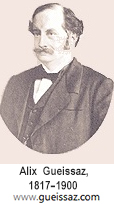

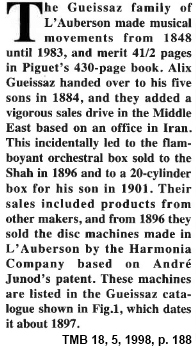
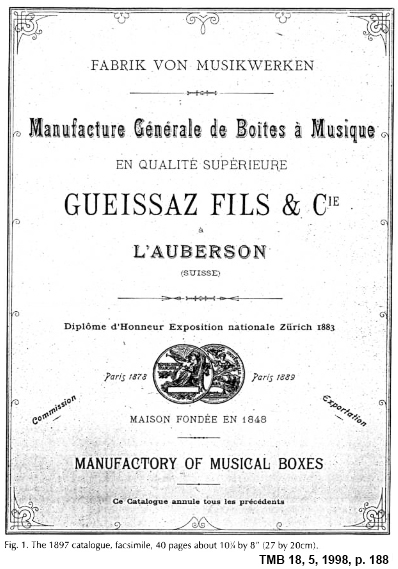
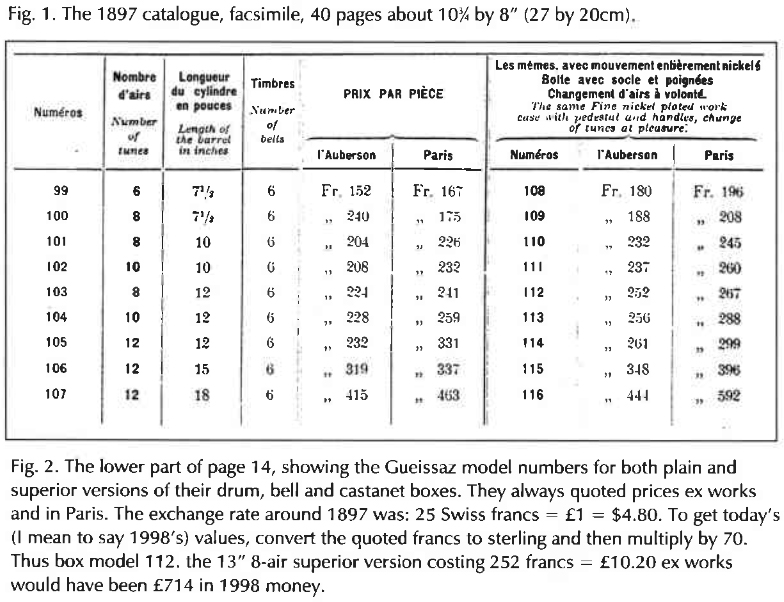
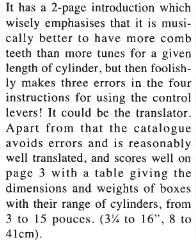
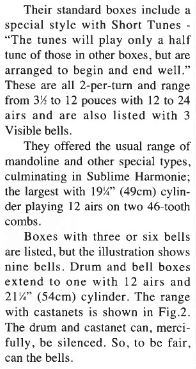

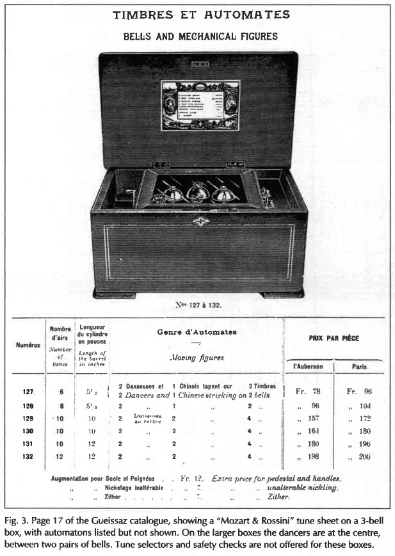
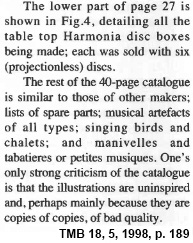

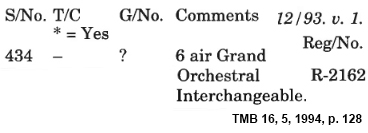
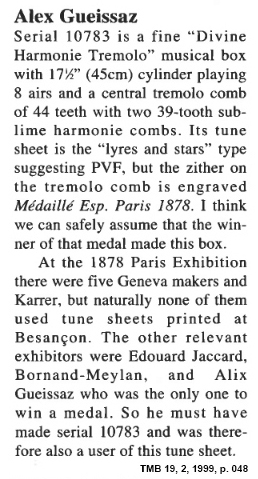
.jpg)
.jpg)


